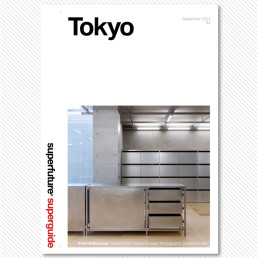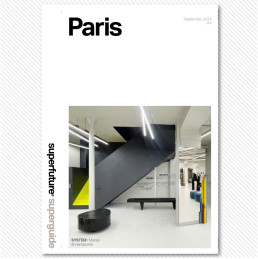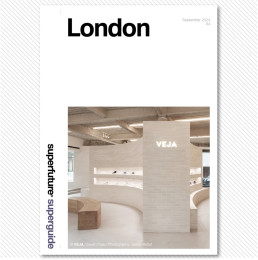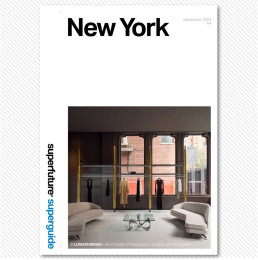
Since its inception seven years ago, sneaker brand Axel Arigato has gone leaps and bounds, following a meticulously formulated holistic approach to put itself on the map in the fast-evolving yet volatile world of fashion and lifestyle. Similar to the brand’s wide range of footwear and related products – mind you, the merchandise is expanding as we speak – the brand’s retail spaces feature a minimalist and crisp interior design that aims to elevate both the shopping and brand experience to a new level. Axel Arigato is on a roll right now, expanding not only its retail network, but also innovating its production line, and last but not least, creating a fanbase that’s aligned with its forward vision. Superfuture recently had the opportunity to sit down with Axel Arigato’s talented and driven creative director Max Svärdh to chat about his work tasks, meticulous brand building, important sustainability issues, and also where the company is headed next.
You work collaboratively with Architect Christian Halleröd to design all of Axel Arigato’s retail spaces. How did your ongoing collaboration with him come about? Also, what’s your say in the design process? I think it was in 2016. We were to open the first Axel Arigato store in London. For us, it was really important from the beginning to create a special retail space. We didn’t want to do it the traditional way, calculating how many products fit in the store, but instead we wanted the opposite, and lead with aesthetics. So, we wanted someone who understood us and the minimalist look and feel we were after. I was in Portugal at the time, talking to three different Swedish architects, and Christian Halleröd was one of them. We hit it off right from the start, and I felt already from the beginning that he understood us as a brand and that we wanted to do something different with the available space.
So, we started to collaborate and he eventually created the interior design for our London store. Ever since, we’ve collaborated on every major retail project. You know, Christian is able to translate the right feel and energy that we want, but also things like functionality and materials. The latter bit we’ve had to learn over the years. We host a lot of events and parties, so we needed to change the design approach, so nowadays we only use very robust materials. Shop floors are particularly tricky, we’ve been talking about it for many years. For us, they also need to double as a nightclub dance floor. It has been an interesting learning curve. Similar to the way we set out to create a brand for next generation customers, we wanted a retail space that adapts to how they consume fashion online and offline. As said, we wanted a minimalist space, but also with something unexpected, such as podiums in the middle of the retail space, and other elements.
Christian and I have also been talking about physical things that become digital. For example, for our Copenhagen store we worked with an artist who created a metal derrière-shaped sculpture where people could sit on and then take a selfie—it’s about creating physical experiences that are shared digitally. We’re not a McDonald’s concept, so all stores look different, but share the same elements, and one of them being our desire to lend our stores a distinct gallery feel. Christian interpreted that notion by not involving the walls in the interior design, a very traditional element in sneaker retail design. Instead, we just focused on podiums to create that gallery feel. All products are presented in the middle of the retail space, while all walls are uncluttered.
So, that’s one key element in all Axel Arigato stores, but it looks different in each one of them. In terms of my personal input in the retail design, it’s hard to say. I’m involved from a very early stage whether it’s functionalities or materials. We’re now working on a spacious new store project in Berlin, and I’m considering putting in a bar, so I come up with a certain functionality like that and Christian interprets it in a presentation, and from there, the design goes back and forth. Basically, it depends on the project—in some, we’re more involved, and in others less. We’re also constantly updating Christian with what we at Axel Arigato are doing, because he needs to know that. For example, we’re expanding into ready-to-wear, and obviously, he needs to take that into account for his interior design. At Axel Arigato we’re constantly pushing ourselves in terms of products, store design, marketing or events, and frankly, we need to do the same with everyone we’re working with.
There seems to be a retail expansion scheme targeting leading cities in Scandinavia and Europe. Actually, we were a little surprised to hear of a new Axel Arigato shop in Dubai. Could you elaborate on the decision to open up shop there, and also, are there any plans to expand further outside Europe? Are all Axel Arigato stores wholly owned or does the retail network also include franchises? Actually, before opening the Dubai store, the Level Shoes store at The Dubai Mall had been a client of us for several years. So, since we already had a relationship with them, opening a standalone store there was an organic process. Because of the relationship with Level Shoes, we had a really good insight which products would work there, and also, Dubai has really evolved over the years in terms of fashion, streetwear, and especially sneakers. Now you’ve even got multi-brand stores and reselling stores there. I’ve been to Dubai several times, actually. A year before the Axel Arigato store had opened, we threw a party, not related to the store opening, with a number of DJs, influencers and people connected to Level Shoes. We’ve also done activations and a campaign there.
Our client base in Dubai comprises a mix of expats, locals, and also a lot of tourists. Mind you, during the pandemic, the city has been one of the very few places that have stayed completely open. As for our overall retail expansion, we’d like to be present in every major city across the globe, starting with the ones in Europe. However, we have our requirements for a location, we’re not interested in opening a shoe box-sized space. It would definitely need to have a certain façade, ceiling height, things like that. The next Axel Arigato store to open is actually in Munich later this month. What we’ve learned from our store in London’s Soho area is that we don’t need to be close to luxury brands or certain other brands, but we need to be in a location with plenty of foot traffic. So, it might as well be an area full of restaurants. We’re definitely not looking for luxury shopping areas, because we’re not at that price point. All Axel Arigato standalone stores our wholly owned, but there are also wholesale operated shop-in-shops, such as the ones at department stores KaDeWe in Berlin and Oberpollinger in Munich. We have no franchise stores.
We’re trying to understand where you’re coming from, from a style point of view: you’re a native of Gothenburg in Sweden. Your hometown is closer to both Oslo and Copenhagen than the Swedish capital Stockholm. Where did young Gothenburgers like you turn for, let’s say, cultural inspiration or did the city have a flourishing scene of its own when you grew up? Starting the Axel Arigato brand here in Gothenburg has pros and cons. Related to both is the fact that you look at the fashion business as an outsider, being so far away from any major city. Growing up, I looked a lot at what was happening in London and New York City, I’ve also been to the U.S. a few times. Actually, I’ve spent a year at a school in Los Angeles. You could say, I looked more to the U.S. than to the Swedish capital or Oslo which are both closer to home.
What’s really important to us as a brand and as people is that we don’t want to be too Swedish, and what I mean by that is that we need different angles and perceptions, otherwise it would be hard to understand what a young kid in New York City finds appealing and how he/she consumes fashion. The entire company has this global focus, and to be honest, being seen as a Swedish brand is my biggest nightmare. Axel Arigato is a global brand with an aesthetic that should appeal to people everywhere. But then again, I think setting up a company in your hometown is always easier because it’s still small scale. Back in 2016, there was only my business partner Albin Johansson and myself doing basically everything, from customer service to shipping orders. At the time, I already ran an online retail business with my mum, and our small Axel Arigato office was located on the premises of that company. If you start a company now, you first get funding and start with a staff of ten people, but back then there were only the two of us. By the way, I sold that other business when we were one year into Axel Arigato.

Tell us about Axel Arigato’s design aesthetic, how would you describe it, and also, what informs it? As I said, minimalism is very much an element that’s innate to Swedish culture, and as such, it has always been a part of our design process. I always say that minimalism isn’t about having very little, but about carefully choosing what not to have, and we’re trying to implement this mindset in the entire customer journey. Whether it’s the interior design, packaging or the website design, it’s like a red thread that runs through every aspect of Axel Arigato. Japanese minimalism is quite similar to Swedish minimalism, but in some ways, it’s also different which makes it interesting. We’ve visited Japan many times, looking at buildings, visiting interesting museums and restaurants, and the country offers a lot that appeals to us because of those similarities. But different!
The sneaker landscape has become more and more saturated with an abundance of brands and collaborations. How do you envisage to make Axel Arigato designs stand out in the market? These days, all brands do sneakers, and I don’t think that’s necessarily a bad thing. Our goal isn’t to exist solely to sell products but to rather embody an entire brand, and therefore, we built this brand universe in which our stores play a pivotal role. This also sheds light on our drive for store expansion. I think this sets us apart from all other sneaker brands. I think we’re work on all that daily basis, we’d like to become more than just a product. Take our Clean 90 plain white sneaker for instance. There are twenty different brands doing the same thing, but I’d like the customer to pick ours for a specific reason, and here’s where the customer journey comes in—every detail counts. As for the product range, we’re very focused on the purpose of the product. We ask ourselves is it a product that’s going to sell the brand or will it drive volumes? We then adapt everything along the process to have a clear direction where we’re headed. Also, we don’t want Axel Arigato to be niche or hyped, we’d like to sell to people of all genders, ages and countries. Our focus on purpose should resonate with everyone.
Axel Arigato has grown into a full-fledged fashion brand, offering The brand now boasts footwear, apparel and accessories for men, women and kids. What’s next for the brand in terms of products and/or collaborations? I want to do it all! But then again, step by step. I mean, we still have tons of things in footwear that need to be perfected. The design team comprises another guy and myself working on footwear, our biggest category, and for apparel there are three designers. The apparel line has been tremendously diversified, and now includes knitwear and outerwear. We recently recruited someone in charge of the objects category which could be anything, really, but it’s currently in full development. However, we’re not planning on launching furniture just yet. I’d definitely be open to collaborations with other brands. Only last week we released a T-shirt collaboration with Pokémon which was a lot of fun to do, also because you need to look at the other brand, and your own brand, from a different perspective. But it’s very important for me to be able to control the narrative otherwise we won’t do it. Right now, we’re working on a couple of collaborations with different artists. Generally, we reach out to artists whose work I find authentic, add a certain value to the product, and fits in our 360° focus.
Sustainability has become a focal point in the fashion and lifestyle industry in recent years, and both procedures and production are continuously upgraded. Could you shed some light on where Axel Arigato stands these days in terms of eco-friendly operations? At Axel Arigato we have two people who exclusively focus on sustainability, and I think that says a lot about our environmental commitment. For the past two years, the main focus of these two colleagues has been traceability of the materials we use and improvement of production procedures. We now only work with Gold or Silver-rated suppliers and certified tanneries, because that’s where the majority of the leather comes from. It took a long time, but this has given us full insight in our entire production line. Because of all this, we now source 95% of our leather from a different main tannery which uses renewable energy, and that’s actually something we urge all of our suppliers to do.
We’ve started measuring our climate impact throughout the entire business enabling us to pinpoint where further improvement is needed. All this applies to Axel Arigato’s entire operations, including the production facilities and supply chain. Additionally, we’ve collaborated with a company called BCOME which enables us to indicate the carbon footprint of a product on our website. Become collects data from each single SKU, and then gives each product points based on shipping, people, CO²-emission, water consumption and so on, so the end customer can see how much that product has affected the environment. For us as a brand, sustainability starts with transparency. By the way, we’re also about to release leather-free products, but it remains to be seen if it’s as durable as actual leather, but I think we need to offer the customer an alternative to leather as it just lasts long. We aim to make quality products that last long enough to eventually be resold if you no longer want it, and that brings me to something I almost completely forgot, the circular element of our business. Coming December, we’ll launch Axel Arigato Xchange, an online platform where customers can sell their pre-owned Axel Arigato footwear and other items.
What’s good in Gothenburg? Where in the city do you prefer to hang out when you have downtime? Any pointers for discerning first-timers? Gothenburg is a fun city, but you have to know where to go. We’re so close to the water here, and almost any Swede has a second home on the west coast or on one of the many islands. So, during summer you’ll find many people out in nature, but in the winter months, I’d like to go clubbing, but not at the venues along Main Street. I like the warehouse parties that are held in Hisingen, an industrial area of town. The parties here are way more interesting. Gothenburg had quite a few nice shops, but soaring rents and online competition has wiped out many, and they’ve been replaced by outlets of big chains. I think it’s a global phenomenon. I really admire what the Shaftesbury real estate trust has done with Soho in London, enabling most of the existing small retailers to stay on, and as such, preserving the character and feel of the neighbourhood.

Publishers Note
Just to be clear – superfuture® is a design blog and not a political commentator. No surprise there. The scope of our content has always been global and borderless, however that can often mean covering projects in countries where we will not agree with the politics or actions of those countries. In a world that’s as screwed up as ever right now, the focus of our support is to those designers, architects and other creatives who aim to make the world a more liveable one – as opposed to people that try their hardest to destroy it. So if a project hits our desk and we like it based on its design credentials, we may choose to publish regardless of its location or creators nationality. superfuture® has always been inclusive and hopes for all current wars, aggression, violence, hate and extremism to end.





